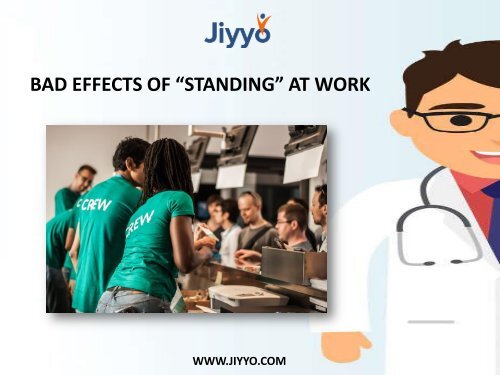Bad Effects Of “Standing” At Work
Doubtless, you have read and understood the problems with the time you spend sitting each day with the risk of ailments of shoulder, spine, hips and heart disease. However, too much standing at work can also cause serious health problems such as blood circulation problem in the legs, blood clots in the lungs and low back pain. An ergonomics researcher from Australia confirms that people who work in standing position enjoy more health benefits as compared to the desk jockeys including burning more calories, using more muscles, improving memory, reducing weight gain and alleviating shoulder and neck strain.
Doubtless, you have read and understood the problems with the time you spend sitting each day with the risk of ailments of shoulder, spine, hips and heart disease. However, too much standing at work can also cause serious health problems such as blood circulation problem in the legs, blood clots in the lungs and low back pain. An ergonomics researcher from Australia confirms that people who work in standing position enjoy more health benefits as compared to the desk jockeys including burning more calories, using more muscles, improving memory, reducing weight gain and alleviating shoulder and neck strain.
You also want an ePaper? Increase the reach of your titles
YUMPU automatically turns print PDFs into web optimized ePapers that Google loves.
BAD EFFECTS OF STANDING AT WORK<br />
WWW.JIYYO.COM
BAD EFFECTS OF STANDING AT WORK<br />
Doubtless, you have read and understood the problems with<br />
the time you spend sitting each day with the risk of ailments<br />
of shoulder, spine, hips and heart disease. However, too<br />
much standing at work can also cause serious health<br />
problems such as blood circulation problem in the legs, blood<br />
clots in the lungs and low back pain. An ergonomics<br />
researcher from Australia confirms that people who work in<br />
standing position enjoy more health benefits as compared to<br />
the desk jockeys including burning more calories, using more<br />
muscles, improving memory, reducing weight gain and<br />
alleviating shoulder and neck strain.<br />
WWW.JIYYO.COM
BAD EFFECTS OF STANDING AT WORK<br />
Risks<br />
Standing at work is very common among factory workers,<br />
restaurant operations, retails assistants, sales personnel. One<br />
study indicates that almost half of all workers worldwide<br />
spend more than three-quarters of their workday standing.<br />
Though, two hours of standing on the job is not associated<br />
with problems but standing five hours a day contributes to<br />
significant and prolonged lower-limb muscle fatigue. This<br />
may raise your risk for long-term back pain<br />
and musculoskeletal disorders (conditions that can affect<br />
your muscles, bones, and joints). It may also lead to:-<br />
WWW.JIYYO.COM
BAD EFFECTS OF STANDING AT WORK<br />
• Sluggish return of blood to the heart<br />
• Pooling of the blood in the legs<br />
• Swelling in the legs<br />
• Night-time leg cramps<br />
• Varicose veins<br />
• Premature birth and unprompted abortion in<br />
pregnant women<br />
• Cardiovascular disease, especially for those standing<br />
in a fixed posture<br />
WWW.JIYYO.COM
BAD EFFECTS OF STANDING AT WORK<br />
Precautions<br />
One of the easiest ways to deal with the problem is to have<br />
routine breaks every 30 or so minutes. This can be done by<br />
moving around to deliver files, copy something, file papers in<br />
file cabinets or use the washroom while standing at one place<br />
or desk.Experts say it is all about change in positions.<br />
Actually, our body does not like to have the same posture or<br />
load placed on it constantly, so change is always better for<br />
the body. Routine breaks actually get the blood moving. You<br />
can also incorporate: –<br />
WWW.JIYYO.COM
BAD EFFECTS OF STANDING AT WORK<br />
• Regular stretching exercises during breaks<br />
• <strong>Work</strong> rotation<br />
• Sitting and standing work alternately<br />
• <strong>Work</strong>stations are set at the proper height and<br />
distance from workers, when relevant<br />
• Avoid bending and twisting too much, as this can<br />
exacerbate the problem<br />
Consult your physician or a physiotherapist about your<br />
change of work habits to determine the optimal solution to<br />
your unique health needs.<br />
WWW.JIYYO.COM







